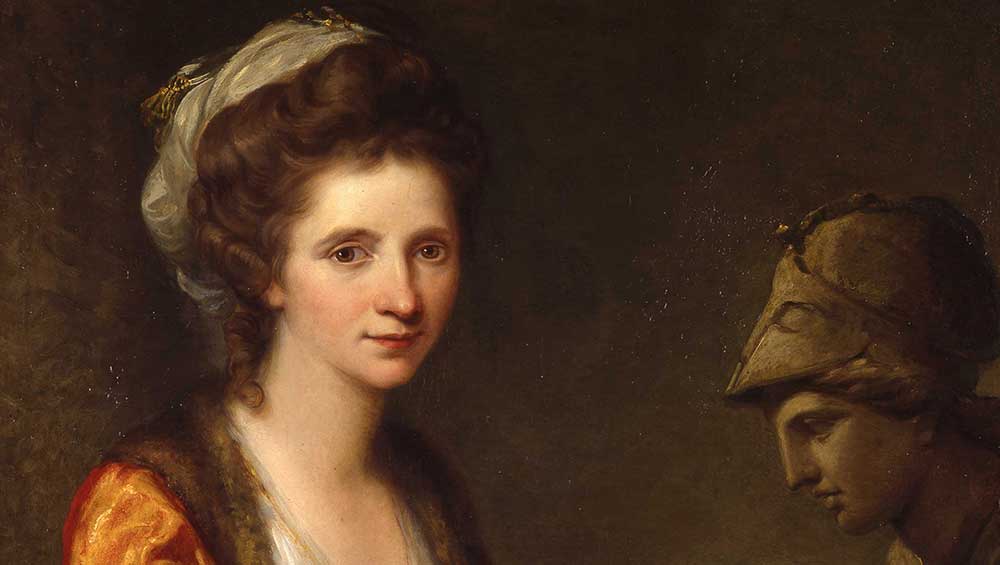
Angelica Kauffman. Self-portrait with Bust of Minerva, c1780-81 (detail). Oil on canvas, 93 x 76.5 cm. Grisons Museum of Fine Arts, on deposit from the Gottfried Keller Foundation, Federal Office of Culture, Bern.
Royal Academy of Arts, London
1 March – 30 June 2024
by ANNA McNAY
It would not be an exaggeration to call this one of the most significant exhibitions in the history of the Royal Academy. Finally, 256 years on, Angelica Kauffman (1741-1807), one of the 36 artists – just two of whom were women (the other being her Swiss contemporary, Mary Moser) – to petition George III to found the Academy in 1768, is belatedly being honoured with a solo show. The exhibition, a victim of Covid (it was originally planned for 2020, and, although necessarily postponed in London, its second leg, at the Kunstpalast in Düsseldorf, took place between summer lockdowns), has been no mean feat for the tenacious curators – Bettina Baumgärtel (from the Kunstpalast, and also head of the Angelica Kauffman Research Project), Per Rumberg (from the National Gallery, London) and Annette Wickham (the Royal Academy’s Curator of Works on Paper) – to reassemble the 30 works, from, luckily, very supportive lenders, for the UK audience.
Kauffman is probably better known from Johan Zoffany’s picture, The Academicians of the Royal Academy (1771-72), than for her own works – although hopefully this will now change. Nevertheless, Zoffany’s painting is a marvellous document – which is included in the exhibition – detailing the 34 male founding Academicians in the life-drawing room, with Moser and Kauffman present only as portraits on the wall (Kauffman is the one on the left), since they were, as women, not admitted to the Royal Academy Schools. You may, however, have unwittingly gazed on – or perhaps been gazed on by – four of Kauffman’s paintings in the entrance hall to the Royal Academy in Burlington House. Collectively known as The Elements of Art (1780), this set of four pictures personifies the characters of Invention, Design, Composition and Colouring, each of them as a woman. Two – Design and Composition – are on display in the exhibition, while the other two are on loan to Tate Britain for its own belated celebration of women artists, Now You See Us: Women Artists in Britain 1520-1920.
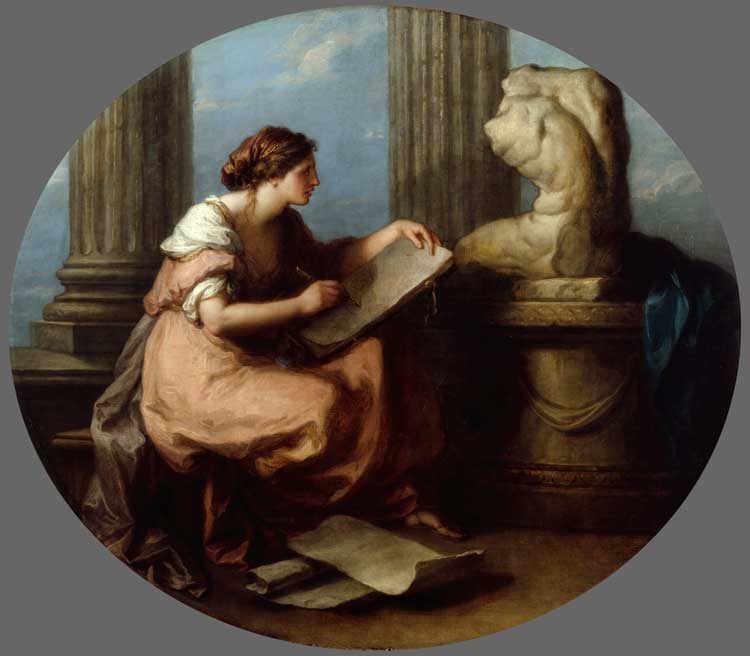
Angelica Kauffman. Design, 1778-80. Oil on canvas, 128.3 x 149 cm. © Royal Academy of Arts, London. Photo: John Hammond.
The commission, originally to decorate the ceiling of the Academy’s rooms at New Somerset House, might be considered Kauffman’s crowning accolade, evidencing the high esteem in which she was held by the Academy, despite the harassment she suffered at the hands of certain of its members, not least Nathaniel Hone. Kauffman’s letter of petition to the Council of the Royal Academy to have a painting by him – The Conjuror (1775) – removed, or else to return her own pictures, is showcased here in a vitrine. The satirical painting was an attack on the president of the Academy, Sir Joshua Reynolds, and it stirred controversy over the nature of his relationship with Kauffman, in its portrayal of an old man and a little girl, and originally (this detail was later painted out) it also included a nude caricature of Kauffman in the top left corner. On Kauffman’s plea, a ballot was held, the outcome of which was in her favour. Accordingly, the painting is not included in this exhibition either.
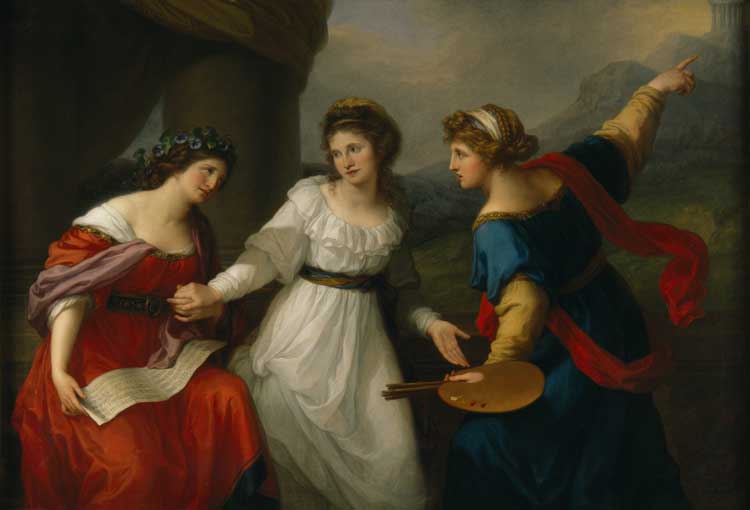
Angelica Kauffman, Self-portrait at the Crossroads between the Arts of Music and Painting, 1794. Oil on canvas, 147.3 x 215.9 cm. National Trust Collections (Nostell Priory, The St. Oswald Collection). Purchased by private treaty with the help of a grant from the Heritage Lottery Fund 2002. Photo: © National Trust Images/John Hammond.
Kauffman was born in Chur, Switzerland, although her father – a muralist and painter – was from the Austrian Tyrol. She was christened Maria Anne Angelica Catherine, but in later years became generally known as Angelica. She was a prodigious talent, who spoke five languages fluently, and was gifted as an artist (she began painting in oils at nine and made her first-known self-portrait at 13) and a musician. In fact, undoubtedly the most beautiful work in the exhibition is Self-Portrait at the Crossroads Between the Arts of Music and Painting, made retrospectively in 1794 when she was 53, which presents herself in the manner of Hercules choosing between Vice and Virtue. Apparently, nine-year-old Kauffman had made this decision rather more easily than is suggested here, when a Catholic priest told her that the opera was a dangerous place filled with “seedy people”, but in the painting she tightly grips Music’s hand, while offering her other hand to Art, who is gesturing up towards a temple on the hills. The colours in the painting are so clear and crisp; the folds of the flowing robes catch the dancing sunlight; and the detail of Art’s braid, Music’s score, the heads of the paint brushes, and the perfectly expressive bent knuckles of each individual finger are breath-taking. We can also observe her almost photographic focus, whereby figures in the distance, and landscapes, are blurry. Art historian Angela Rosenthal describes Kauffman’s frequent use of landscapes as backdrops to her portraits as depicting “a landscape of the soul, which represents not the exterior world, the expanse of nature, but rather an internal world”1. This is fitting here, as well as, for example, in Portrait of Henrietta Maria Hill (as the muse Erato) (1792), where the leafy green trees reflect the sitter’s abundant curls and virginal fecundity.
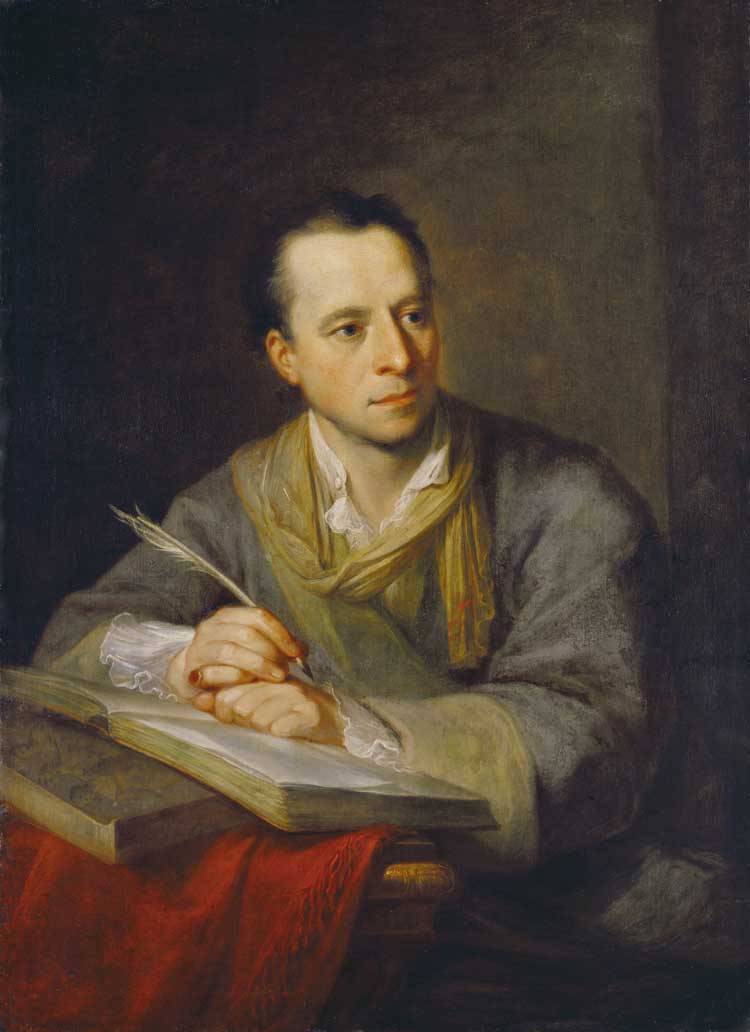
Angelica Kauffman, Portrait of Johann Joachim Winckelmann, 1764. Oil on canvas, 97 x 71 cm. Kunsthaus Zurich, Gift of Conrad Zeller, 1850. © Kunsthaus Zurich.
Alongside her talent, Kauffman was armed with an unwavering determination to succeed as a history painter. In the 18th century, the hierarchy of genres dictated that history painting – taking themes from ancient literature, history and mythology, and considered to represent universal truths and ideals – was the most prestigious, followed some way behind by portraiture. And succeed she did. Early on, she was encouraged by the art historian and archaeologist, Johann Joachim Winckelmann (whose portrait, on show here, she painted in 1764) and, ultimately, she was one of only six out of the Royal Academy’s 36 founding members to be designated a history painter. In 1778, the London Chronicle observed: “It is surely somewhat singular that while so many of our male artists are employed upon portraits, landscapes and the other inferior species of painting, this lady should be almost uniformly carried, by the boldness and sublimity of her genius, to venture upon historical pieces.”2
History painting further provided the opportunity for Kauffman to demonstrate the breadth of her classical grounding, and, like other painters of this genre, she often gave her pictures long, explanatory titles, as much to educate her audiences as to show her own knowledge. An example here is Eleonora Sucking the Venom Out of the Wound of Her Husband, King Edward I (1776). Kauffman took not only from Ovid and Virgil, but from Renaissance poetry, Shakespeare and Goethe. The last was to become a close friend during his time in Rome, once again sparking rumours of more, alongside suggestions that her marriage to the Venetian painter Antonio Zucchi, who was 15 years her senior, was one purely of convenience. In fact, Kauffman appears to have been devoted to both.
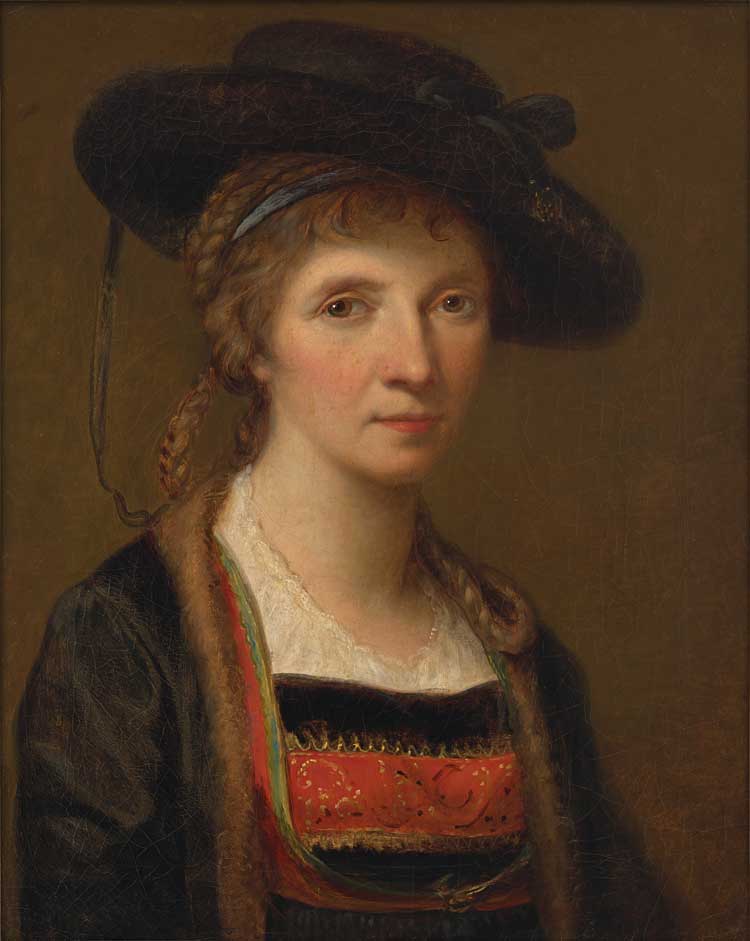
Angelica Kauffman. Self-portrait in the Traditional Costume of the Bregenz Forest, 1781. Oil on canvas, 61.4 x 49.2 cm. Innsbruck, TLM, Ältere kunstgeschichtliche Sammlung, inv. Gem 301. Photo: Innsbruck, Tiroler Landesmuseen.
The exhibition opens, however, with a room of self-portraits. Self-Portrait in the Traditional Costume of the Bregenz Forest (1781) acknowledges her paternal roots. A much earlier self-portrait in this same dress (Self-Portrait in the Traditional Costume of the Bregenz Forest, Seated at her Easel, c1757-59, not exhibited) is in the collection of the Uffizi in Florence. However, later in her career, Kauffman deemed this one “unworthy”3 of herself, and so she made a new one, Self-Portrait in all’antica Dress (1787) (on loan here), which she presented to the museum as a replacement. It was well received, and Kauffman was delighted when she learned that it had been hung alongside none other than Michelangelo’s self-portrait in the Uffizi’s hall of fame – no matter, then, that at the age of 40 she had painted herself fresh faced and youthful. It is estimated that Kauffman made 24 self-portraits, which, out of a total of about 1,000 works, is a small number. In fact, she didn’t leave all that much for biographers and art historians to work with, keeping no diaries and burning most of her correspondence, since she disliked the thought of “quiet passages of friendly communication being published”4. Thankfully, Zucchi had commenced a memorandum of the works she produced (Memoria delle piture [sic] fatte d’Angelica Kauffman), which she kept up with after his death. A page from this is also on display in the final room.
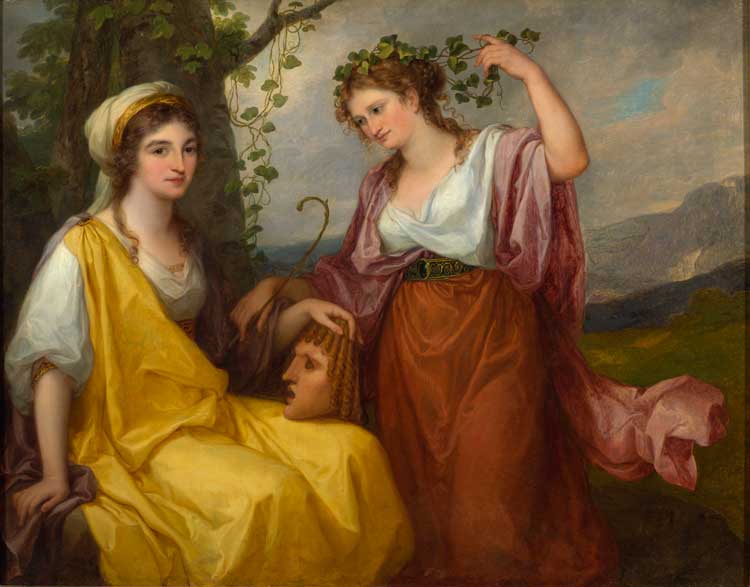
Angelica Kauffman, Portraits of Domenica Morghen and Maddalena Volpato as Muses of Tragedy and Comedy, 1791. Oil on canvas, 125 x 158 cm. National Museum in Warsaw MNW. Photo © Collection of National Museum in Warsaw. Photo: Piotr Ligier.
Despite being a founding member of the Academy, and one who exhibited every year, even after having returned to Italy, Kauffman, as a woman, was, as already noted, barred from the Schools and from life-drawing classes. In his Inquiry into the Real and Imagined Obstructions to the Acquisition of the Arts in England of 1775, Irish painter and fellow Academician James Barry made it clear that: “As to the notion that the portrait-painter can also, when called upon, paint history, and that he can, merely from his acquaintance with the map of the face, travel with security over the other regions of the body, every part of which has a peculiar and difficult geography of its own; this would be too palpably absurd to need any refutation.”5 This was something of a double-edged sword for Kauffman, since, although placing her at a disadvantage in the handling of nude male heroes in her history paintings (for which she, like many female artists of the time, studied plaster casts of classical sculptures – as depicted in Design), it meant she improvised and found ways to tell these stories with the female characters taking centre stage. This is exemplified here in Death of Alcestis (1790), in which the heroine takes up the traditionally heroic (and, therefore, male) posture on a deathbed. One of the earliest history paintings on display is Penelope at Her Loom (1764), and Penelope suited Kauffman very nicely as a subject who was, in her own right, a female creative.
A less happy female protagonist is Poor Maria, whom Kauffman portrayed a number of times, including here in a charmingly rococo, small, oval painting from 1777. Paired with Shakespeare’s Tomb (1772), both are oil on copper, and I would happily take either home with me, their pastel prettiness successfully persuading me to forgive the awful proportions of Poor Maria’s dog. (As the story goes, she was deserted even by her pet goat – so thank goodness for the loyalty of dogs!)
Of course, Kauffman also painted portraits, and this was how, in the early years, she made her living. Having come to London on the persuasion of Lady Wentworth, the wife of the British ambassador in Venice, she was afforded introductions to many from the upper echelons of society. Kauffman was not naive, however, and she had sent her portrait of the actor David Garrick (now one of a number in the Burghley House Collection) to London ahead of her arrival, knowing that it would attract attention and act as something of a calling card. The King’s sister, Augusta, Duchess of Brunswick, was an early visitor to her studio, and the first of the family to have her portrait painted by Kauffman. It was well received in society, and Kauffman was soon introduced to Queen Charlotte, with whom she spoke German and made good friends. (In fact, the Queen was to be a great support to her when she found herself in a pickle having married a fraudster claiming to be Count Frederick de Horn, while he was actually the count’s former vassal.) We sadly only get to see a mezzotint of Kauffman’s portrait, Her Majesty Queen Charlotte Raising the Genius of the Fine Arts (1772), thus titled to celebrate her support and patronage of female artists, including her having lobbied for the admission of Kauffman and Moser as founding members of the Academy.
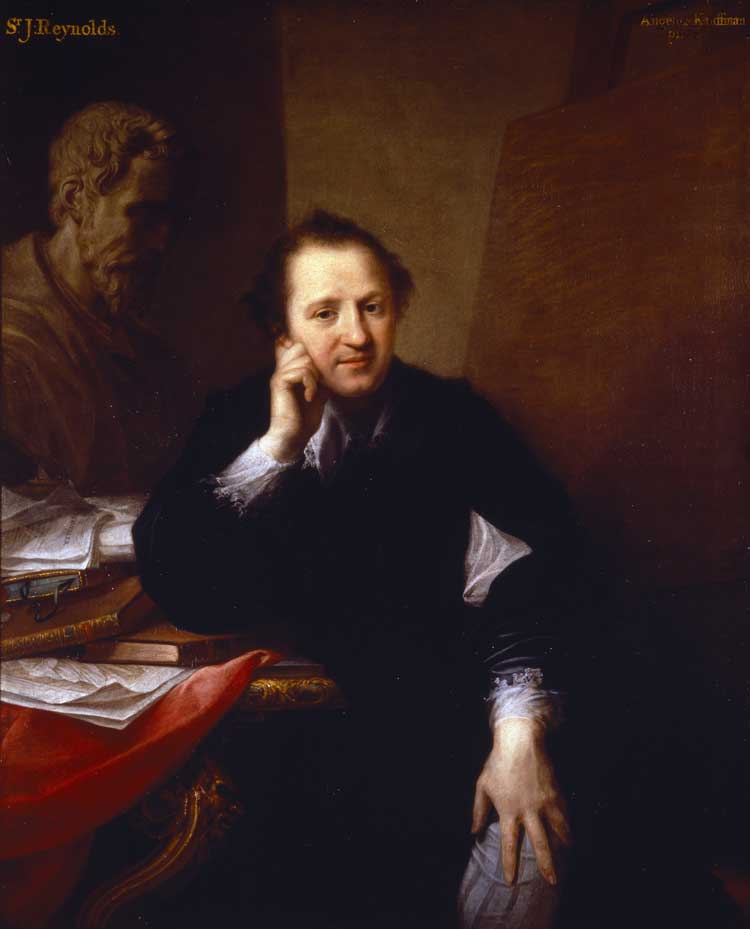
Angelica Kauffman, Portrait of Joshua Reynolds, 1767. Oil on canvas, 127 x 101.6 cm. National Trust Collections, Saltram, The Morley Collection (accepted in lieu of tax by H. M. Treasury, and transferred to The National Trust in 1957). Photo: © National Trust Images/Rob Matheson.
Kauffman’s greatest acquaintance in London remains, however, Reynolds, who is doubtless to thank for her involvement with the Academy. Beyond that, however, they were also close friends and artistic allies. She painted him a flattering portrait – glossing over “both his smallpox scars and his disfigured upper lip”6 – and he painted hers. In a later picture, Self-Portrait with Bust of Minerva (1780-84), it has been suggested that Kauffman, through the inclusion of the sculpture, is referring back to her composition for Reynolds, whereby he was shown surrounded by his books and papers, with a bust of Michelangelo symbolising the inspiration that passes between artists. Reynolds also later produced a self-portrait including the same bust of Michelangelo. The inspiration and artistic conversation is thus seen to be going strong.
In a letter to her father, soon after arriving in London, Kauffman wrote: “I have finished some portraits which are snapped up by everyone, Mr Reynolds is excessively pleased with them. I have painted his portrait, which has turned out very well and does me much honour, it will soon be engraved.”7 From the outset, Kauffman also set her prices in line with Reynolds’, and her success in spite of – or perhaps because of – this ought not to be underestimated.
Kauffman received a great many commissions for portraits of wives, daughters, husbands and families. She frequently painted her female sitters in harem-style dress, as in Portrait of Martha Cocks in Turkish Dress with Embroidery Frame (1772), which also exemplifies her inclusion of objects as, if you like, attributes (here recalling Penelope with her loom). Her aforementioned portrait of Henrietta Maria Hill so “delited”8 Hill’s husband, Charles Brudenell-Bruce, that he commissioned one of himself as its pendant. He additionally requested that he be dressed in the style of a Van Dyck portrait, another wheeze Kauffman often employed to flatter her aristocratic male sitters.
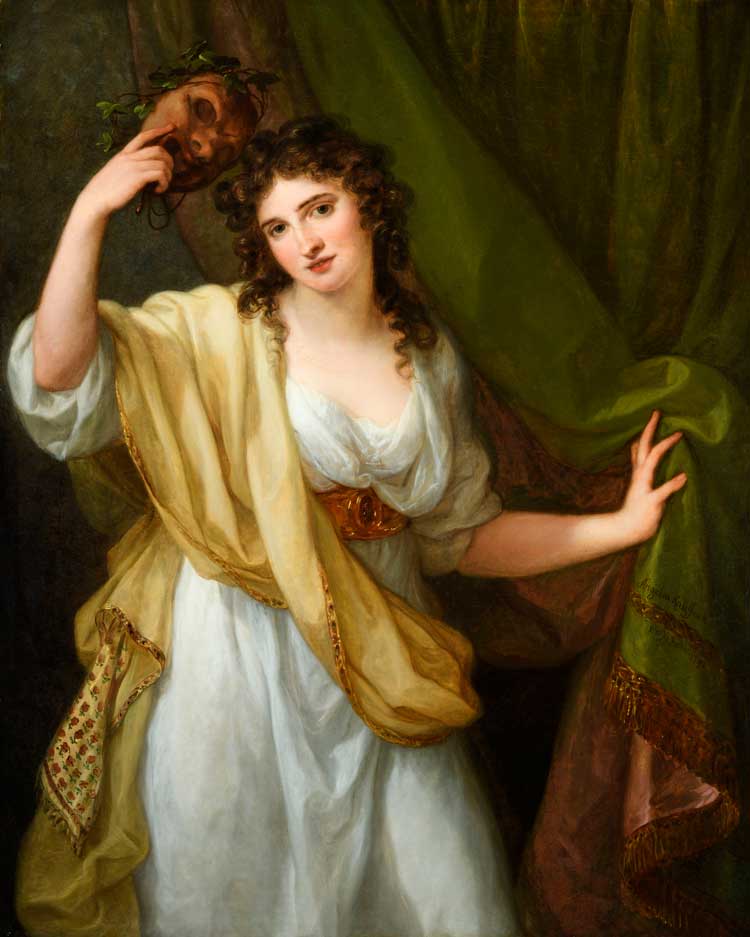
Angelica Kauffman. Portrait of Emma, Lady Hamilton, as Muse of Comedy, 1791. Oil on canvas, 127 x 101.6 cm. Private collection.
A number of less formal portraits allowed Kauffman to fuse her love of art and performance. Portrait of the Impromptu Virtuoso Teresa Bandettini Landucci as Muse (1794), for example, shows the poet, crowned with a laurel wreath, arms raised, gesticulating as she recites her work. And, of course, Kauffman also got to paint the It girl of the time, the actor Emma Hart (who was to become Lady Hamilton). A surviving letter from the artist reads: “How often have I wished … to see and be acquainted with Mrs Hart … And I confess to envy especially all the artists who were so fortunate at least to attempt an imitation of so graceful an object. There are beauties in nature not to be imitated. Yet I should certainly strive to do the utmost in my power to give at least an idea of that grace which even in nature one seldom does find, and the which Mrs Hart possesses in the highest degree.”9 Her portrait captures Hart’s baby-soft, pale lemon skin and decolletage, blushing cheeks, flowing ringlets, and beautiful yellow silk scarf, trimmed with embroidered rosebuds. Afterwards, knowing Hart to be in receipt of the finished picture, Kauffman wrote to her: “Had your Ladyship made a longer stay in Rome – I should have produced a better picture approaching nearer to the model inimitable – and so excellent in mind, and person … all I can say is that your Ladyship bestows your kindness upon one truely gratefull my Respect and Estime towards you My Lady is truely sincere – and unalterable.”10
The work in the exhibition made latest in Kauffman’s life is Christ and the Samaritan Woman (1796), a beautifully balanced composition reproducing a traditional Jesus-figure in conversation with one of the artist’s blushing maidens. In her final years, Kauffman turned her hand to more religious works, with this one being commissioned for a monastery (albeit later acquired by King Ludwig I of Bavaria). Along with another religious work, David and Nathan (1806-07) (not included in the exhibition), it was still in her studio when she died, aged 66, in 1807. Due to her high ranking, she was given a lavish Roman funeral in the style of Raphael’s, arranged by her close friend, the sculptor, Antonio Canova. These two paintings were carried in the grand procession. Back in the UK, a detailed account of the event was not only read out to the General Assembly meeting of the Royal Academy, but also transcribed in full in the minutes.
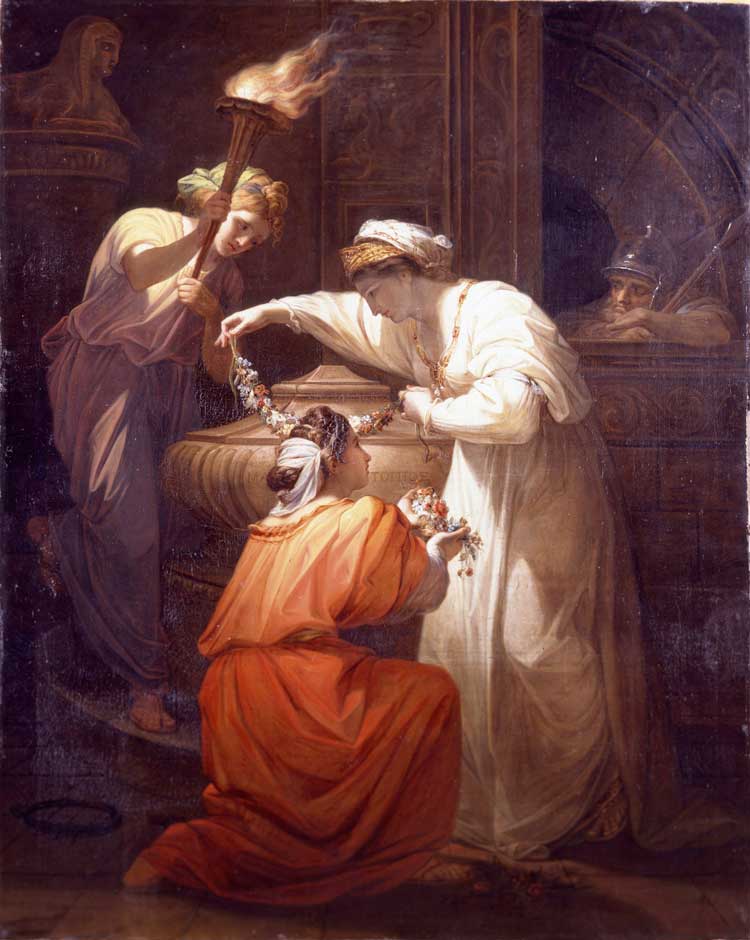
Angelica Kauffman. Cleopatra Adorning the Tomb of Mark Anthony, c1765. Oil on canvas, 125.5 x 105 cm. The Burghley House Collection. Photo © The Burghley House Collection.
Despite numerous successes by female artists at Royal Academy exhibitions (and their occasional nomination for election) throughout the 18th and 19th centuries, there was not to be another female Royal Academician – after Kauffman and Moser – until Laura Knight in 1936. Taking this, and the fact that last year’s Marina Abramović exhibition was the first ever solo outing for a female artist in the Royal Academy’s main galleries, it is perhaps hardly surprising, if nonetheless shocking, that it has taken more than a quarter of a millennium for Kauffman to get her just deserts. Barry’s recognition of her brilliance, when speaking of Self-Portrait at the Crossroads as follows, is only now being heard: “Some may say that this is great, since it was executed by a female; but I say, that whoever produced such a picture, in whatever age or whatever country, it is great, it is noble, it is sublime.”11
References
1. Eighteenth-Century Women Artists: Their Trials, Tribulations and Triumphs by Caroline Chapman, Unicorn Publishing, 2017, page 80.
2. Angelica Kauffman, exhibition catalogue, Royal Academy of the Arts, London, 2024, page 29.
3. Ibid, page 38.
4. Miss Angel. The Art and World of Angelica Kauffman by Angelica Goodden, Pimlico Books, London, 2005, page 307.
5. Ibid, page 121.
6. Eighteenth-Century Women Artists: Their Trials, Tribulations and Triumphs, Op cit, page 89.
7. Miss Angel. The Art and World of Angelica Kauffman, Op cit, page 82.
8. Angelica Kauffman, exhibition catalogue, Royal Academy of the Arts, London, 2024, page 86.
9. Miss Angel. The Art and World of Angelica Kauffman, Op cit, page 214.
10. Angelica Kauffmann, RA: Her Life and Her Works by Victoria Manners, Forgotten Books, London, 2018 (first published 1924), page 87.
11. Angelica Kauffman, exhibition catalogue, Royal Academy of the Arts, London, 2024, page 87.